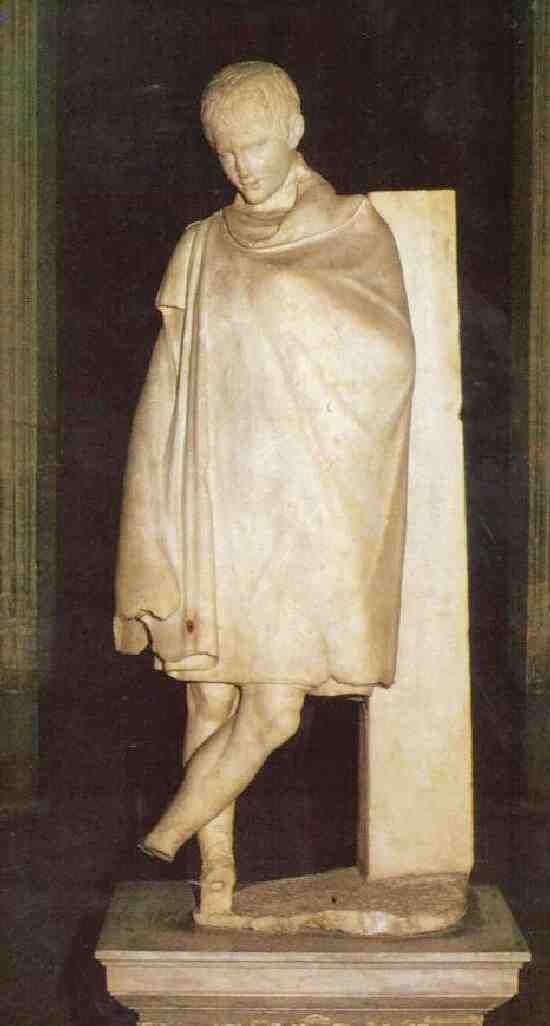
Ancient Rome: Boys' Clothing: Cloaks

Figure 1.--This sculpture was found at Ephebos? in Turkey. It dates to about ????. Here we are not sure why the boy was sculpted with a cape. We suspect that it was easier than attempting to do the body with more involved clothing. The boy looks to be about 12 years old. He is apparently wearing a tunic under his cloak. Image courtesy of the Fergusson Image Collection.
|
|
Cloaks and other over garments were worn in inclemate or cold weather.
Italy is of course located in the Mediterranean and the climate is generally warm, especially in the south of the peninsula. There is of course a winter which can be quite cold, especially in the north. In additions Romans lived outside of Italy. Thus cold weather clothing was needed. One of the primary garments was the cloak which was worn by men, women, and children. Here I do not yet know if there was any stylistic differences for the cloaks worn by men, women, and children. A variety of cloaks are mentioned in the written record, but it is not entire clear what the characteristics of some of these cloks were. Children wore these cloaks were over their tunics, the cloaks did not replace the tunics. The cloaks unlike the tunics might be brightly colored. As there have been a wide range of Romman documents found, including personal letters, we know quite a bit about domestic matters, including clithing and fashion. We note a father presumably from a rural area who wrote to his son some time in 2nd centuury AD. He was boarding in a town to pursue his education. The letter is "From Cornelius to his sweetest son Hierax". His father tells him,
"...Take care not to offend any of the persons at home, and give your undivided attention to your books, devoting yourself to learning, and then they will bring you profit. Receive by Onnophris the white tunics which are to be worn with the purple cloaks [i.e. shawls], the others you should wear with the myrtle-colored ones. I shall send you by Anoubas both the money and the monthly supplies and the other pair of scarlet cloaks." The claks also might have ornamenyl paches.
The sculpture seen here is referred to as "The Ephebos Youth" (figure 1). I am not sure, but I think that wasa Roman city in Asia Minor (modern Turkey). The marble statue shows a boy wearing a cape or cloak pulled
around him. It is very plain. He is wearing sandles. His hair is short. He is thought to be resting after exercising. The statue depicts a boy in a relaxed pose and it has a feeling of being a snapshot photograph of a moment in the education of a child.
Sources
Can, Turham. Istanbul - Gateway to the Orient (Istanbul Publisher Orient Turkish Ltd.).
William Fergusson
HBC

Navigate the Historic Boys' Clothing Web Site:
[Return to the Main ancient Rome clothing page]
[Introduction]
[Activities]
[Art chronologies]
[Biographies]
[Countries]
[Photography]
[Style Index]
[Bibliographies]
[Contributions]
[FAQs]
[Glossaries]
[Images]
[Links]
[Registration]
[Tools]
[Boys' Clothing Home]
Created: August 16, 2003
Last updated: 10:23 PM 10/15/2008



